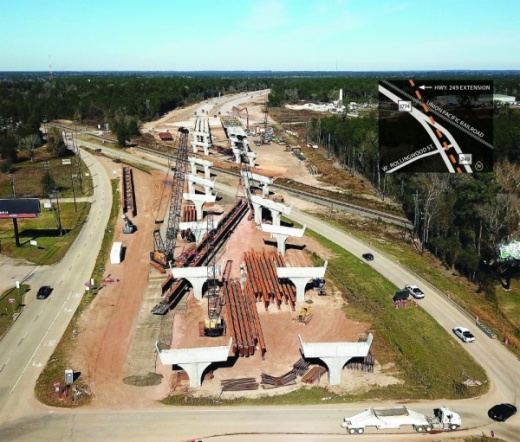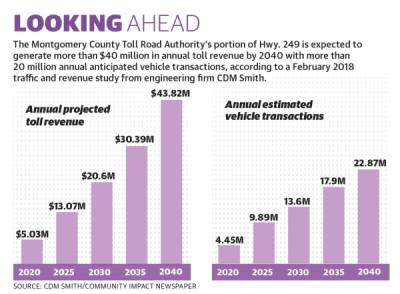The Harris and Montgomery county toll road authorities have been working with the Texas Department of Transportation since 2017 to extend the Tomball Tollway—the tolled portion of Hwy. 249—from FM 2920 in Tomball to FM 1774 in Todd Mission with a nontolled segment to Hwy. 105 in Navasota, Community Impact Newspaper previously reported.
About three years after construction began on the Hwy. 249 extension in Harris County, the MCTRA’s portion of the roadway—stretching from Spring Creek to just south of FM 149 in Pinehurst—will open to drivers in February, Precinct 2 Commissioner Charlie Riley said.
“My daddy told me years ago that [the Hwy. 249 extension] would happen one of these days, but I wouldn’t live long enough to see it,” Riley said. “Well, it’s here, and I’m excited that I get to be the commissioner to see it through after all these years.”
TxDOT’s Segment 1A, spanning from FM 1774 in Pinehurst to FM 1488 in Magnolia, will also open to the public in summer 2020, TxDOT Public Information Coordinator Rachel Evans said.
As the Hwy. 249 extension comes to fruition, economic and residential growth is expected to follow in the southwest portion of Montgomery County this year, said Tana Ross, the economic development coordinator and planning technician for the city of Magnolia, in a Dec. 6 email.
“Developments that have been in the planning for years—many residential ones and many commercial ones—will be turning dirt shortly and opening in 2020,” she said in the email.
Montgomery County portion
The Harris County Toll Road Authority’s Phase 2 of the Tomball Tollway opened to drivers in mid-December, extending the Hwy. 249 tolled main lanes from FM 2920 to Spring Creek. The $130 million project features a six-lane tollway with three-lane frontage roads on either side and ties into the MCTRA’s portion north of Spring Creek, Community Impact Newspaper previously reported.The MCTRA’s $63 million segment spans 3.6 miles with two main lanes in each direction between existing frontage roads, according to MCTRA documents.
The project includes construction of a main toll gantry as well as tolled entrance and exit ramps. Toll prices are slated to be $1.25 at the main toll gantry north of Decker Prairie Road and $0.50 for the two ramp toll gantries south of Vallie Street in the Decker Prairie area, according to a February 2018 traffic and revenue study by engineering firm CDM Smith.
Drivers must have an EZ Tag or another Texas toll tag to pay the new tolls—the same options available on the Harris County portion, Riley said.
“Drivers will have a nonstop route from FM 1488 all the way down to [Beltway 8]. You can get on [Hwy. 249] and never have a stop,” Riley said. “Do you know how much more time that means these people can spend with their families, rather than in the car?”
By 2022, drivers are estimated to save 16 minutes during evening peak traffic times when traveling northbound on the tollway from Spring Cypress Road to FM 1774 in Pinehurst instead of the Hwy. 249 frontage road, the traffic and revenue study shows. The time savings amount is expected to grow to 26 minutes by 2040, the study states.
The MCTRA sold nearly $89 million in revenue bonds in June 2018 to help fund the entity’s segment of Hwy. 249 as well as repay the county for loaned funds, Community Impact Newspaper previously reported. This means the tollway will be funded from future toll revenue—only by those who use the tollway—rather than property taxes, Riley said.
Annual toll revenue is expected to total $5 million in 2020 and increase to $43.8 million by 2040, according to the traffic and revenue study. Although county commissioners unanimously voted to remove the tolls on the Hwy. 242 flyover above I-45 in late May, Riley said he does not anticipate tolls to be removed on MCTRA’s portion of Hwy. 249 after the project is paid off.
“I think even more people will use Hwy. 249 than we could ever anticipate,” Riley said. “There’s always the option to use the frontage roads if you don’t want to pay the tolls, but once that road comes through here...everyone will want that safer, more convenient route.”
Extension through Magnolia
In addition to the MCTRA’s segment opening, TxDOT will open the first of its three segments this summer, Evans said.TxDOT’s Segment 1A is the first segment of a 14-mile, four-lane portion of the tollway with intermittent frontage roads from FM 1774 in Pinehurst to FM 1488 in Magnolia. Segment 1B will continue from FM 1488 to FM 1774 in Todd Mission, with an expected completion date of spring 2021, Evans said.
Segment 2 will feature a nontolled, two-lane highway with no frontage roads between FM 1774 in Todd Mission and Hwy. 105 in Navasota and is expected to open in spring 2023, Evans said.
Two main toll gantries will be located along the $347 million Segment 1: one between FM 149 and FM 1488 and one north of FM 1486, TxDOT information shows. Toll prices at the main gantries will be $1.71 for standard vehicles, according to a minute order from the Texas Transportation Commission. There will also be tolled entrance and exit ramps with varying toll prices along Segment 1.
Toll payments by EZ Tag and TxTag will be accepted on Segment 1, Evans said. She said pay-by-mail will also be an option on this segment, a difference from the MCTRA and HCTRA portions.
“[The project] efficiently links suburban communities and major roadways and will overall enhance regional connectivity and mobility,” she said in an email.
Once Segment 1A and the MCTRA’s portion are open, commuters will be able to spend less time on the road, which opens up the Greater Magnolia area to more residents, Magnolia Mayor Todd Kana said.
“Part of the reason I no longer work in Houston is because after 18 years of the commute, it was just unbearable,” he said. “For those looking to move out here but have been reluctant because of the drive, or those already commuting into Houston, this will be an attraction for them.”
Growth and public safety
Large-scale transportation projects such as Hwy. 249 tend to bring rooftops and retail with them, Ross said.For example, TxDOT’s Hwy. 249 segments will be constructed through part of Audubon Magnolia, a planned 3,300-acre master-planned community under development near FM 1488 and FM 149.
Audubon Magnolia, developed by Sam Yager Inc., will bring approximately 5,000 homes at build-out, •Community Impact Newspaper •previously reported. A construction timeline for Audubon Magnolia could not be provided as of press time Dec. 20.
H-E-B is also slated to break ground in Magnolia Place, a development •proposed for the FM 149, FM 1488 and Spur 149 area just west of where Hwy. 249 will cross FM 1488 in Magnolia, in the first quarter of 2020, Ross said. This groundbreaking will occur just before the main lanes of Hwy. 249 through Montgomery County are set to open.
“As development is a puzzle, the resulting population increase projected with [Hwy.] 249 brings residential developments, which in turn attract conveniences like H-E-B, entertainment venues and restaurants,” Ross said.
However, the expected increase in residential growth and economic development will also increase demand for emergency services as well as increase the need for more fire stations, staff and equipment, said Gary Vincent, the chief of the Magnolia Volunteer Fire Department.
The fire department—funded by Montgomery County Emergency Services District No. 10—receives property tax revenue and a portion of sales tax revenue within ESD 10’s 185-square-mile boundaries. However, there is a lag between when the demand for increased service arrives and when the fire department receives additional revenue, Vincent said.
“If you build a house today and people move into it, it still takes several years before it actually hits the tax roll and generates revenue for government [entities], even though they still require [emergency] service on move-in day,” he said. “How do we provide service to all of these people with no immediate increase in revenue? We’ll make it work, but it’s a challenge.”







